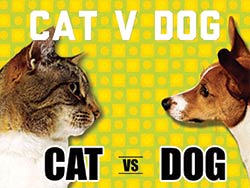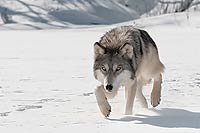 If you have both a dog and a cat, which do you consider more athletic? I’m guessing most people believe their dog is the animal athlete in the family, because generally speaking, canine companions tend to have a higher activity level than their indoor-only feline counterparts. If you have both a dog and a cat, which do you consider more athletic? I’m guessing most people believe their dog is the animal athlete in the family, because generally speaking, canine companions tend to have a higher activity level than their indoor-only feline counterparts.
Among the many differences between dogs and cats is the way their bodies are designed. According to the online publication Bark, anatomic differences between dogs and cats start with a tendon in the neck called the nuchal ligament.
The nuchal ligament attaches the head to the spine and is an adaptation designed to stabilize the head in animals that run fast and far. The nuchal ligament that dogs have is like the one that horses have. It supports the head without using muscles, thus saving energy and making the animal more efficient.
1. Dogs: Long Distance Runners
Dogs evolved over time to have longer leg bones to maximize the length of their stride, and since they relied primarily on their scenting abilities to hunt and chase prey, they also evolved longer noses and necks. (In contrast, cats rely on their ears and eyes to hunt and stalk prey up close.) The nuchal ligament helped early dogs conserve energy while running down scent trails over long distances with their noses to the ground.
While dogs lost dexterity of their front limbs and evolved relatively weaker neck muscles needed to take down prey alone, they compensated by evolving group hunting techniques. Dogs, humans and horses have nuchal ligaments and are designed to run long distances. You know who doesn’t have a nuchal ligament? Cats don’t.
 2. Cats: Short Distance Sprinters 2. Cats: Short Distance Sprinters
Unlike dogs, cats are solitary hunters. They also don’t run their prey down as dogs do. Instead, they rely on stealth, explosive power and flexibility. From a sitting crouch, a cat can jump up to nine times their height, and in a split-second they can make sudden changes in direction and twist their spines mid-fall to land on all fours.
It’s true that most of the time, cats land on their feet, thanks to their “righting reflex.” When a cat is falling, he’s able to orient himself in midair so that he lands on his feet. The fall has to be at least a foot in height, but cats have survived much longer falls. This could be because they tend to spread their bodies out to increase drag.
One of the reasons cats often walk away from a fall that would seriously injure or even kill a dog is that the feline spine is much more flexible. Their vertebral bones have increased elasticity in the disc between bones when compared to a dog, which is why cats don’t have the back problems that dogs tend to have.
A cat’s vertebrae also is less tightly connected than a dog’s, making the spine far more flexible, and a cat’s pelvis and shoulders are more loosely attached to its backbone than dogs. A cat can stretch their body and run with a stride length of three times their body length.
A cat’s flexible spine, powerful muscles and retractable/extendable claws that provide traction like runner’s spikes all contribute to top speeds of 30 miles per hour.
There’s a reason the cheetah is the fastest animal in the world. However, a cat can only sustain this kind of anaerobic activity for very short periods of time, which makes a cat a fantastic sprinter but a terrible distance runner.
Other factors that make dog and cats vastly different:
3. Dogs are easier to obedience train — Dogs can be trained quickly, some in a matter of minutes, to obey basic commands like come and sit. Most cats are difficult if not impossible to train to respond to directives.
4. Cats are easier to housetrain — Cats can be housetrained in an instant as long as they have access to a litter box. There’s really no training to it, in fact. It’s instinct. Most dogs take considerably longer to housetrain, and some just never get all the way there. Unlike with a cat, housetraining a pup is usually a hands-on, time intensive project.
5. Dogs are social; cats are solitary — Dogs want to be with their pack, wherever their pack may be. Cats are solitary by comparison and their primary attachment (when forced to choose) is to their territory rather than other two or four-legged companions (but this does not mean cats don’t form strong bonds with humans).
6. Dogs have a dozen more teeth than cats — Dogs have 42 teeth. Cats have 30.
7. Cats aren’t earthbound like dogs are — Cats can jump and climb, giving them more options when they need to hunt for food, or when they feel threatened. Dogs are earthbound, so they need their pack to hunt effectively. And when a threat triggers their fight-or-flight response, they’re more likely to react with aggression because their ability to flee from a predator is limited.
8. Dogs and cats are carnivores … but different types — Dogs are scavenging carnivores, which means although they’re primarily meat-eaters, if necessary they can survive on plant material alone (remember, surviving is different than thriving). Cats are obligate or strict carnivores and as such, cannot sustain life without eating meat in some form.
9. Dogs can go without food much longer than cats can — Cats can’t be fasted and should not be dieted down too quickly. Their bodies don’t convert stored fat to energy nearly as efficiently as humans or dogs, which can result in a life-threatening liver condition called hepatic lipidosis if they go without food for a period of time.
10. Cats have retractable claws — Cats have retractable claws that stay sharp because they are protected inside the toes. Dogs’ claws are always extended and become blunt from constant contact with the ground when they walk.
Dog-Friendly Walks/Hikes
in the Moab Area |
Corona Arch - Easy/Moderate. 1.3 Miles one way. Trailhead is 25 minute drive from Moab.
North on US-191 to Potash Road (Utah 279).
Mill Creek Pathway - Easy. 1.1 Miles. Little to no driving. Starts at the intersection of 100 South and 100 West,
a block off of Main Street.
Portal Overlook - Hard. 2.0 Miles one way. Trailhead is 20 minute drive from Moab.
North on US-191 to Potash Road (Utah 279).
Grandstaff Canyon - Moderate. 2.0 Miles one way. Trailhead is 10-minute drive from Moab.
North on US-191 to the River Road (Utah 128) |
|